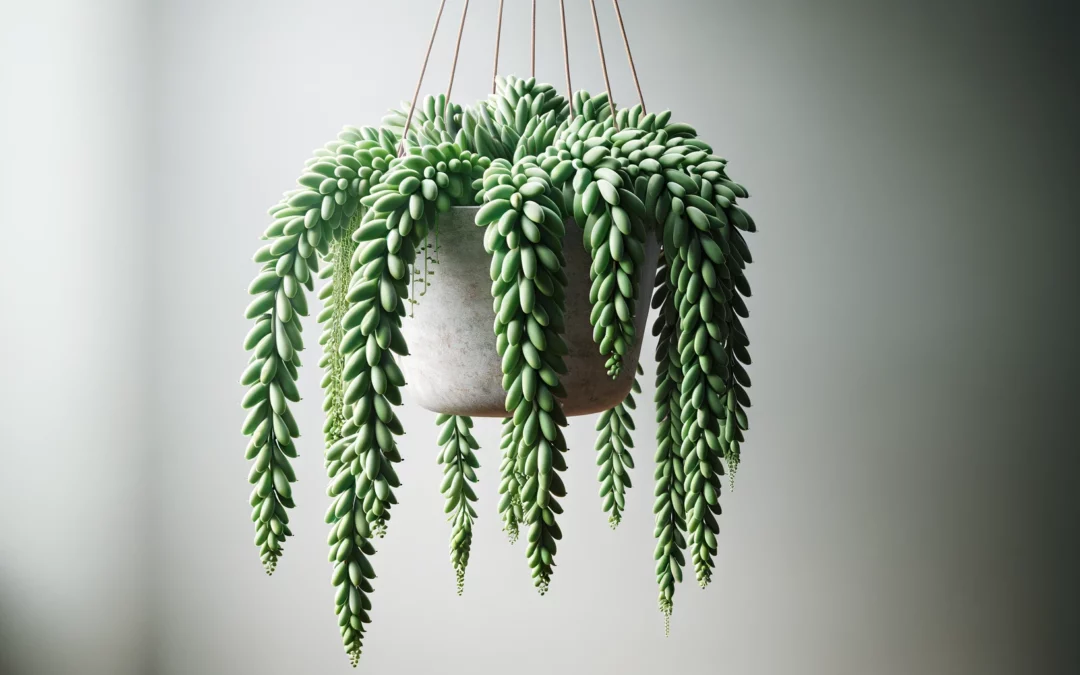Welcome to our guide on the string of bananas plant care! It’s a great choice for anyone wanting a striking, low-maintenance succulent. It’s from South Africa and has glossy, banana-like leaves. These leaves dangle down, making a beautiful display.
The string of bananas is simple to take care of, even if you’re not good with plants. It thrives with right care and a bit of attention. We’ll show you how to make your string of bananas plant healthy and happy.
Let’s get started and learn how to care for your plant!
Key Takeaways:
- String of bananas is a trailing succulent with glossy, banana-shaped leaves.
- It requires bright, indirect sunlight and well-draining soil.
- Keep the plant out of reach of children and pets as it is toxic.
- Water the plant when the soil is completely dry to prevent overwatering.
- Use a succulent potting mix or DIY mix of potting soil, perlite, and pumice/sand.
Light Requirements for String of Bananas
The string of bananas is a lovely plant that needs the right light to grow well. It has beautiful cascading leaves. Ensuring it gets enough light is key to its health.
It thrives in bright, indirect light. A spot near a south-facing window works great. This lets it get lots of sunlight. Yet, if there’s not enough natural light, use artificial grow lights.
Without proper light, it may grow leggy. The stems could stretch and leaves spread out. Good light helps keep its appealing shape.
In its natural home, it does best in zones nine to eleven. These areas are warm and provide ample light.
How to Provide Adequate Light for Indoor Plants
Indoor plants do well when their environment mimics the outdoors. Here are some pointers for bright light:
- Place the plant near a south-facing window to maximize sunlight exposure.
- Rotate the plant periodically to ensure even light distribution on all sides.
- Supplement natural light with grow lights if needed, especially in rooms with limited sunlight.
- Keep curtains or blinds open during the day to allow maximum light penetration.
“Proper lighting is crucial for the string of bananas plant to maintain its attractive cascading form and promote healthy growth.” – Gardening Expert
Getting the right light is crucial for your string of bananas. These tips will ensure it grows beautifully. This brings a touch of nature into your home.
| Light Requirements for String of Bananas | Indoor Plants | Natural Habitat |
|---|---|---|
| Bright, indirect light | Perfect for indoors | Native to South Africa, grows in USDA zones nine, ten, and eleven |
| Place near south-facing window or use grow lights | Replicate natural habitat | Ensure optimal light exposure |
| Prevent leggy growth and spaced-out leaves | Achieve attractive cascading form | Provide the right growing conditions |
Watering Requirements for String of Bananas
The string of bananas is a succulent with low water needs. Knowing the right way to water it is key for its health.
This plant likes well-draining soil and wants water only when the soil is dry to the touch. How often you water it depends on the weather, how dry the air is, and the soil type. To check if it’s time to water, stick your finger in the soil. If it’s dry down to your first knuckle, water your plant.
When you water, water it well but don’t overdo it. Let the water soak through the soil to the roots. Too much water can harm it by causing root rot. Remember, it’s better for this plant to be a little dry than too wet.
Too little water makes the leaves droop and look wrinkly. But too much water causes the leaves to turn yellow, the roots to rot, and can even kill the plant. It’s safer to water less often than to water too much.
A moisture meter is a great help in checking if your plant needs water. This tool tells you exactly how much moisture is in the soil. With a moisture meter, you can be sure you’re watering your string of bananas just right.
Consistent and correct watering is crucial for a happy string of bananas. If you get to know your plant’s water needs and water it the right way, it will reward you with its beauty year after year.
Key Takeaways:
- The string of bananas requires watering when the soil is completely dry.
- Factors such as temperature, humidity, and potting mix influence the frequency of watering.
- Thoroughly water the plant, allowing excess water to drain out and prevent root rot.
- Underwatering is preferable to overwatering for the string of bananas.
- A moisture meter can help determine the soil’s moisture levels accurately.
| Watering Method | Frequency | Signs of Underwatering | Signs of Overwatering |
|---|---|---|---|
| Thoroughly water when the soil is completely dry | Varies based on temperature, humidity, and potting mix | Wilted and wrinkled leaves | Yellowing leaves, root rot |
Soil Requirements for String of Bananas
Growing a healthy string of bananas plant starts with choosing the right soil. It needs well-draining soil to stay away from root rot and keep healthy. A succulent potting mix is the best for the string of bananas. It has the perfect mix of holding moisture and letting air move, which is key for succulents.
For those who like to make things themselves, you can mix up your own soil. Mix potting soil, perlite, and pumice/sand in equal parts. This will make the right kind of soil for your plant. Perlite and pumice/sand make the soil drain well, so your plant doesn’t get too much water.
Tip: Adding leca balls can improve your soil mix. These are porous clay balls. They help air get to the plant’s roots and can take the place of some soil, making drainage better.
Picking the right soil for your string of bananas is crucial for its health. The soil should keep the right amount of moisture but not get too wet. This stops the plant from getting sick because of too much water around its roots.
| Soil Requirements for String of Bananas |
|---|
| Well-draining soil is essential to prevent root rot |
| A succulent potting mix is the ideal choice |
| DIY mix: Potting soil + perlite + pumice/sand |
| Consider adding leca balls for improved drainage |
Temperature and Humidity Requirements for String of Bananas
The string of bananas is easy to grow inside. It likes the same temperatures and humidity we do. But, it needs the perfect setting to grow strong and last a long time.
Keeping it away from big changes in temperature is key. Quick weather shifts can hurt the plant. Don’t put it near open windows or AC vents.
This plant is fine with various temperatures, but it doesn’t like frost. Once it gets colder than 65 degrees Fahrenheit outside, move it indoors. You might need a heater to keep it cozy if it gets too cold.
Moisture in the air is also important for the string of bananas. It’s from places that are quite damp. So, it likes a bit more humidity than in most houses.
You can make the area around the plant more moist by using a tray with pebbles and water. Or, use a humidifier nearby. This will help keep the humidity right for the plant.
Setting the right temperature and humidity makes the string of bananas happy. Keep an eye on these things to help it grow well and stay healthy.
Fertilizing Requirements for String of Bananas
The string of bananas plant doesn’t need to be fertilized often. Giving it a small boost during the spring or summer makes it grow better and healthier. It’s best to use organic fertilizers. They keep the plant free from harmful chemicals. Organic choices include worm compost, liquid kelp, and fish emulsion. They provide the right nutrients for the plant’s health.
When you fertilize, mix the fertilizer with water at a 50/50 rate. This stops the plant from getting too much food. It lets the bananas plant take in nutrients slowly. Remember, it’s better to give a little than a lot with fertilizer. Too much can hurt the plant.
It’s good to feed the string of bananas every few weeks when it’s growing. This is mostly in spring and summer. The plant needs food to be its best during these times.
“Effective fertilizing can greatly contribute to the optimal growth and vitality of your string of bananas plant.”
Organic Fertilizers for String of Bananas
Choosing organic fertilizer is a smart move for your string of bananas plant. These fertilizers are good for the earth. Plus, they help your plant grow strong. Organic options include worm compost, liquid kelp, and fish emulsion.
| Fertilizer | Composition |
|---|---|
| Worm compost | A nutrient-rich mixture of organic matter produced by worms, enhancing soil fertility |
| Liquid kelp | Derived from seaweed, it contains essential minerals and growth hormones |
| Fish emulsion | A concentrated liquid made from fermented fish, provides a wide range of nutrients |
Worm compost, liquid kelp, and fish emulsion are easy to find. You can get them at garden stores or online. Trying different organic fertilizers will help you pick the best one for your bananas plant.
Propagation of String of Bananas
The string of bananas plant is cool because you can make more just by cutting its stems. This way, you grow your succulent collection for free. It’s fun and lets you watch your plants grow in a special way.
For this, look for strong, healthy stems that are not damaged. Then, use sharp scissors to cut them. Make sure they are at least 4 to 6 inches long.
After cutting, let the stems sit for a day or two. This waiting time is key. It stops them from rotting and helps them heal over.
Next, it’s time to plant the stems. Use a mix that drains well, like with perlite. Put the cutting in the soil, about 2 inches deep. Do this gently.
Remember! The plant needs something to lean on until it grows roots. Water it well after planting. But, don’t drown it. Misting daily helps the roots grow better.
Spring or summer is the best time to do this. The plant is more likely to grow then. Soon, it will start making roots.
After a couple of weeks, treat it like a grown string of bananas plant. Give it good light and water it sparingly. Now you’ve added a plant to your garden or your friend’s garden.
Propagating this plant brings joy and helps you connect with others who love plants. It’s a great way to share the beauty of your green space.
Conclusion
The string of bananas is perfect for new gardeners. It has glossy, banana-shaped leaves and grows beautifully. You need bright light, good soil, and not too much water to take care of it.
Keep your plant in regular room temperatures and avoid frost. You don’t have to add fertilizer, but if you do, use it just a little. Spring or summer are the best times for this.
To get more plants or share with friends, use its stem cuttings. Cut healthy stems in spring or summer. Let them dry, then plant in good soil. Make sure to water them until they grow.
With these simple steps, your string of bananas will thrive. It brings years of beauty and joy. Whether you love plants or are new to gardening, this plant will add charm to your home.

